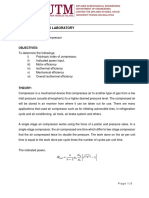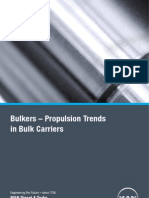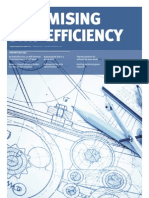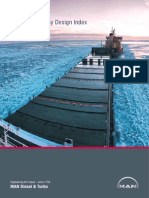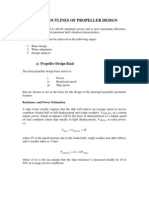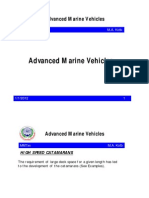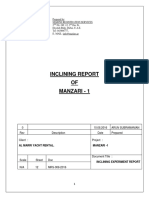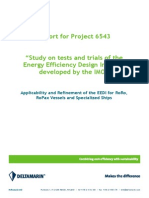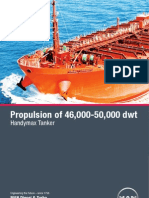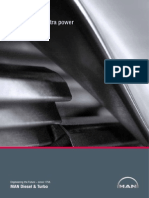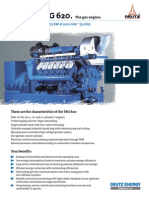Improved Efficiency and Reduced Co2
Improved Efficiency and Reduced Co2
Uploaded by
chrisvakarisCopyright:
Available Formats
Improved Efficiency and Reduced Co2
Improved Efficiency and Reduced Co2
Uploaded by
chrisvakarisOriginal Title
Copyright
Available Formats
Share this document
Did you find this document useful?
Is this content inappropriate?
Copyright:
Available Formats
Improved Efficiency and Reduced Co2
Improved Efficiency and Reduced Co2
Uploaded by
chrisvakarisCopyright:
Available Formats
Improved Efficiency
and Reduced CO
2
3 Improved Efficiency and Reduced CO
2
Content
Introduction ................................................................................................. 5
Major Propeller and Main Engine Parameters ................................................ 5
Propeller ................................................................................................. 6
Main engine ............................................................................................ 6
Ship with reduced design ship speed ...................................................... 6
Case Study 1 ............................................................................................... 6
75,000 dwt Panamax Product Tanker ...................................................... 6
Basic case .............................................................................................. 7
Derating of main engine .......................................................................... 8
Increased propeller diameter ................................................................... 8
Reduced fuel consumption per day or per voyage ................................... 8
Case Study 2 ............................................................................................... 9
4,500 teu Panamax Container Vessel ...................................................... 9
5-propeller blades ................................................................................. 10
4-propeller blades ................................................................................. 10
6-propeller blades ................................................................................. 10
Reduced fuel consumption per day ....................................................... 11
Reduced fuel consumption per voyage .................................................. 12
Case Study 3 ............................................................................................. 13
8,000 teu Post-Panamax Container Vessel ............................................ 13
Propeller diameter of 8.8 m ................................................................... 14
Increased propeller diameter of 9.3 m ................................................... 14
Reduced fuel consumption per day ....................................................... 15
Reduced fuel consumption per voyage .................................................. 16
Summary ................................................................................................... 17
5 Improved Efficiency and Reduced CO
2
Improved Efficiency and Reduced CO
2
Introduction
One of the future goals in the marine in-
dustry is to reduce the impact of CO
2
emissions from ships in order to meet
the coming stricter International Mari-
time Organisation (IMO) greenhouse
gas emission requirements.
Two CO
2
emission indexes are being
discussed at IMO, an Energy Efficiency
Design Index (EEDI) and an Energy Ef-
ficiency Operational Indicator (EEOI).
The EEDI is used to evaluate the engine
and vessel design and the EEOI is used
to guide the operator in developing the
best practices on board.
The goal is to design future ships with
a design index to be stepwise reduced
in the period from 2012 to 2018 to a
maximum level of possibly 70% com-
pared with the 100% design index valid
for average designed ships of today.
However, it should be emphasised that
neither goal nor indexes are definite yet,
June 2009.
As a reduction in CO
2
emission is
roughly equivalent to a reduction in fuel
consumption, the goal for the manufac-
turers will roughly correspond to a 30%
reduction in fuel consumption per voy-
age of future ships in normal, average
service.
Based on case studies on three differ-
ent ships, this Paper shows the influ-
ence on fuel consumption of derating
the main engine in general and using
electronically controlled engines and,
particularly, of reducing the ships serv-
ice speed in combination with selection
of the optimum propeller design.
All main engines discussed are opti-
mised/matched in compliance with the
IMO Tier II emission requirements, even
though an improved fuel consump-
tion usually also means increased NO
x
emissions. Furthermore, all ships have
Fixed Pitch Propeller (FPP) types and
the (two-stroke) main engines are di-
rectly coupled with the propeller and,
therefore, have the same speed as the
propeller.
In order to improve the overview of the
relative changes of the fuel consump-
tion and CO
2
emissions in this Paper,
relative reduction of figures are stated
with minus (-) and relative increase of
figures are stated with plus (+).
The three case studies and main pa-
rameters analysed are:
1. 75,000 dwt Panamax Product Tanker at
15.1 knots ship speed
Nomi nal l y rated 5S60MC-C8 ver-
sus derated 6S60MC-C8 and
6S60ME-C8
Influence of derating of engine
Influence of derating and increased
propeller diameter
Influence of using electronically con-
trolled engine
2. 4,500 teu Panamax Container Vessel at re-
duced ship speed
6S80ME-C9 and 6K80ME-C9 versus
8K90MC-C6 and 9K90MC-C6
Influence of reduced ship speed
Influence of changed number of pro-
peller blades
3. 8,000 teu Post-Panamax Container Vessel
at reduced ship speed
Derated 9S90ME-C8 versus
10K98ME7 and 12K98ME-C7
Influence of reduced ship speed
Influence of increased propeller di-
ameter
Major Propeller and Main Engine
Parameters
In general, the larger the propeller diam-
eter, the higher the propeller efficiency
and the lower the optimum propeller
speed referring to an optimum ratio of
the propeller pitch and propeller diam-
eter.
When increasing the propeller pitch
for a given propeller diameter, the cor-
responding propeller speed may be
reduced and the efficiency will also be
slightly reduced, but of course depend-
ing on the degree of the changed pitch.
The same is valid for a reduced pitch,
but here the propeller speed may in-
crease.
The efficiency of a two-stroke main en-
gine particularly depends on the ratio of
the maximum (firing) pressure and the
mean effective pressure. The higher the
ratio, the higher the engine efficiency,
i.e. the lower the Specific Fuel Oil Con-
sumption (SFOC).
Furthermore, the larger the stroke/bore
ratio of a two-stroke engine, the high-
er the engine efficiency. This means,
for example, that a super long-stroke
engine type, e.g. an S80ME-C9, may
have a higher efficiency compared
with a short-stroke engine type, e.g. a
K80ME-C9.
6 Improved Efficiency and Reduced CO
2
Compared with a camshaft (mechani-
cally) controlled engine, an electronically
controlled engine has more parameters
which can be adjusted during the en-
gine operation in service. This means
that the ME/ME-C engine types, com-
pared with the MC/MC-C engine types,
have relatively higher engine efficiency
under low NO
x
IMO Tier II operation.
When the design ship speed is re-
duced, the corresponding propulsion
power and propeller speed will also be
reduced, which again may have an in-
fluence on the above-described propel-
ler and main engine parameters.
The following is a summary of the major
parameters described:
Propeller
Larger propeller diameter involving:
Higher propeller efficiency
Lower optimum propeller speed
(rpm)
Lower number of propeller blades in-
volving:
Slightly higher propeller efficiency
Increased optimum propeller speed
(rpm) (from 6 to 5 blades means ap-
proximately 10% higher rpm)
Main engine
Increased p
max
/p
mep
pressure ratio in-
volving:
Higher engine efficiency (e.g. by de-
rating)
Larger stroke/bore ratio involving:
Higher engine efficiency (e.g. S-type
engines have higher efficiency com-
pared with K-type engines)
Use of electronically controlled engine
instead of camshaft controlled:
Higher engine efficiency (improved
control of NO
x
emissions)
Main ship particulars assumed:
Scantling draught m 14.2
Design draught m 12.6
Length overall m 228.6
Length between pp m 219.0
Breadth m 32.2
Sea margin % 15
Engine margin % 10
Design ship speed kn 15.1
Type of propeller FPP
No. of propeller blades 4
Propeller diameter m target
Ship with reduced design ship
speed
Lower propulsion power demand and
lower propeller speed.
Case Study 1
75,000 dwt Panamax Product Tanker
Based on a ship with unchanged ship
speed, this case study illustrates the
po tential of reduced fuel consumption
when derating a main engine and when
using a four-bladed propeller with an
increased propeller diameter. Together
with the main engine types involved,
the ship particulars in question are as-
sumed as follows:
7 Improved Efficiency and Reduced CO
2
Basic case
As Alt. 1, the basic ship refers to a
nominally rated 5S60MC-C8 main en-
gine with SMCR = M1 = 11,900 kW x
105.0 r/min and a design ship speed of
15.1 knots, see Fig. 1a. In this figure the
layout diagrams of the 5 and 6S60MC-
4,000
80 85 90 95 100 105 110 115 r/min
Engine/Propeller speed at SMCR
6,000
8,000
10,000
12,000
14,000
16,000
Propulsion
SMCR power
kW
SMCR power and speed are inclusive of:
15% Sea margin
10% Engine margin
5% Propeller light running coefcient
Constant ship speed coefcient = 0.3
Derating of main engine
16.0 kn
15.5 kn
15.0 kn
15.1 kn
14.5 kn
M2
M3/M4
M1
14.0 kn
13.0 kn
D
prop
=7.2 m
n
blade
=4
D
prop
=6.8 m
n
blade
=4
D
prop
=6.95 m
n
blade
=4
=0.3
=0.3
=0.3
M = SMCR
M1 = 11,900 kW at 105.0 r/min 5S60MCC8
M2 = 11,900 kW at 105.0 r/min 6S60MCC8
M3 = 11,680 kW at 98.7 r/min 6S60MCC8
M4 = 11,680 kW at 98.7 r/min 6S60MEC8
105 r/min
5
S
6
0
M
C
C
8
/M
EB
8
/M
EC
8
6
S
6
0
M
C
C
8
/M
E
B
8
/M
E
C
8
Fig. 1a: Different main engine and propeller layouts and SMCR possibilities (M1, M2, M3, M4) for a 75,000 dwt Panamax product tanker operating at the same
ship speed of 15.1 knots
C8/ME-C8 engine types and the SMCR
points M1, M2, M3 and M4 at 15.1
knots are also drawn in together with
the propeller curves valid for the three
different propeller diameters of 6.8 m,
6.95 m and 7.2 m, each with four pro-
peller blades.
8 Improved Efficiency and Reduced CO
2
Alt. 1: 5S60MCC8 nominal (Basis)
SMCR=11,900 kW at 105 r/min
Alt. 2: 6S60MCC8 derated
SMCR=11,900 kW at 105 r/min
Alt. 3: 6S60MCC8 derated
SMCR=11,680 kW at 98.7 r/min
Alt. 4: 6S60MEC8 derated
SMCR=11,680 kW at 98.7 r/min
M1
M2
M3
M4
25
30
35
40
45
50
65 70 75 80 85 90 95 100 %SMCR
Engine shaft power
Fuel consumption
per day
t/24h
Reduced fuel consumption by derating
IMO Tier ll compliance
Average service load
80% SMCR
Reduction () of fuel consumption:
Total Total Propeller Engine
t/24h % % %
0.00 0.0 0.0 0.0
1.14 2.9 0.0 2.9
1.60 4.1 1.8 2.3
2.39 6.1 1.8 4.3
Fig. 1b: Relative fuel consumption in normal service of different derated main engines for a 75,000 dwt Panamax product tanker operating at 15.1 knots
Derating of main engine
When installing a 6S60MC-C8 as Alt. 2,
i.e. with one extra cylinder, it is possible
to derate this engine to the same SMCR
point as the nominally rated 5S60MC-
C8, i.e. with SMCR = M2 = M1, and
thereby reducing the fuel consumption
in service at 80% SMCR by -2.9%, see
Fig. 1b.
Increased propeller diameter
Furthermore, when changing the aft-
body of the ship it may be possible,
as Alt. 3, to install a larger propeller di-
ameter of 7.2 m with a corresponding
SMCR = M3 = 11,680 kW x 98.7 r/min
valid for a derated 6S60MC-C8.
Reduced fuel consumption per day
or per voyage
Main engine 6S60MC-C8
For Alt. 3, Fig. 1b shows a reduction in
the fuel consumption of -4.1%, obtained
by a combination of improved propeller
and main engine efficiencies.
Main engine 6S60ME-C8
A further reduction of the fuel con-
sumption is obtained by installing an
electronically controlled main engine
as Alt. 4 with the same SMCR = M4 =
M3. According to Fig. 1b, the total re-
duction achieved with a 6S60ME-C8
is -6.1%, i.e. with an extra -2% reduc-
tion in the fuel consumption compared
with the 6S60MC-C8. The reason is
that the ME-C type, compared with the
MC-C IMO NO
x
Tier II engine type, has
a higher engine efficiency as a result of
its improved ability to adapt to the NO
x
emission requirements of IMO Tier II.
9 Improved Efficiency and Reduced CO
2
Main ship particulars assumed:
Scantling draught m 13.3
Design draught m 12.0
Length overall m 286
Length between pp m 271
Breadth m 32.2
Sea margin % 15
Engine margin % 10
Type of propeller FPP
Propeller diameter m 8.3
No. of propeller blades target
Design ship speed kn target
Case Study 2
4,500 teu Panamax Container Vessel
Based on a ship with unchanged propel-
ler diameter, this case study illustrates
the potential of reduced fuel consump-
tion by lowering the design ship speed
from its original 24.7 knots. The study
focuses on the influence of the number
of propeller blades and the correspond-
ing impact on the selected main engine
types which are able to obtain the de-
sign ship speed of 22.0 knots. Together
with the main engine types involved,
the ship particulars in question are as-
sumed as follows:
10 Improved Efficiency and Reduced CO
2
0
65 70 75 80 85 90 95 100 105 110 r/min
Engine/Propeller speed at SMCR
10,000
20,000
30,000
40,000
50,000
Propulsion
SMCR power
kW
SMCR power and speed are inclusive of:
15% Sea margin
10% Engine margin
5% Propeller light running margin
Constant ship speed coefficient = 0.07
Number of propeller blades changed
6S80MEC9
8S70MEC8
9K90MCC6
25.0 kn
24.5 kn
24.0 kn
24.7 kn
M1
M4
M2
M3
23.0 kn
21.0 kn
22.0 kn
21.5 kn
n
blade
=6
n
blade
=5
n
blade
=4
= 0.07
= 0.07
D
prop
=8.3 m
8K90MCC6
+0.7%
78 r/min
104 r/min
In
c
re
a
s
e
d
p
itc
h
N
o
rm
a
l p
itc
h
N
o
r
m
a
l p
it
c
h
R
e
d
u
c
e
d
p
it
c
h
N
orm
al pitch
R
educed pitch
6K80MEC9
M = SMCR
M1 = 41,130 kW at 104.0 r/min 24.7 kn 9K90MCC6 (Reference)
M2 = 36,560 kW at 104.0 r/min 24.0 kn 8K90MCC6
M3 = 26,900 kW at 104.0 r/min 22.0 kn 6K80MEC9
M4 = 27,060 kW at 78.0 r/min 22.0 kn 6S80MEC9
Fig. 2a: Different main engine and propeller layouts and SMCR possibilities (M1, M2, M3, M4) for a 4,500 teu Panamax container vessel with different design
ship speeds
5-propeller blades
A nominally rated 9K90MC-C6 with
SMCR = M1 = 41,130 kW x 104.0 r/min,
a design ship speed of 24.7 knots and
5 propeller blades is used as reference,
see Fig. 2a. The optimum (normal pitch)
propeller curve with 5 blades through
M1 indicates the corresponding SMCR
power and speed point M of the main
engine for lower design ship speeds.
Point M2 = 36,560 kW x 104.0 r/min
is valid for a nominally rated 8K90MC-
C6 placed on a propeller curve with re-
duced pitch and 5 propeller blades and
is able to obtain the design ship speed
of 24.0 knots.
At 22.0 knots the needed SMCR point
is approx. 26,800 kW x 90 r/min. The
drawn-in layout diagram of an 8S70ME-
C8 with L1 = 26,160 kW x 91.0 r/min,
and still valid for a 5-bladed propeller,
indicates that the maximum design ship
speed obtainable for this engine type is
approx. 21.8 knots.
4-propeller blades
When reducing the number of propeller
blades from 5 to 4, the corresponding
optimum SMCR (normal pitch) propeller
curve is moved to the right with an ap-
prox. 10% higher propeller speed and
is shown together with a similar SMCR
propeller curve with reduced propeller
pitch.
On the latter curve through 22.0 knots,
the SMCR = point M3 = 26,900 kW
x 104.0 r/min is shown. This point is
placed in the top of the layout diagram
of the 6K80ME-C9 engine.
6-propeller blades
The corresponding SMCR = point M4
= 27,060 kW x 78.0 r/min for 22.0
knots with increased propeller pitch is
also shown, but now valid for the in-
creased number of propeller blades to
be 6, which involves a reduction of the
optimum propeller speed. Point M4 is
equal to the nominal MCR point of the
6S80ME-C9 engine.
11 Improved Efficiency and Reduced CO
2
60
14
70
80
90
100
110
120
130
140
150
160
170
180
21.5 22.0 22.5 23.00 23.5 24.0 24.5 25.0 25.5 kn
Design ship speed
t/24h kg/24h/teu
Fuel consumption per day
50
60
70
80
90
100
110
120
130
%
Relative fuel
consumption
per day
24.7 kn
24.0 kn
22.0 kn
16
18
20
22
24
26
28
30
32
34
36
38
40
8
0
%
S
M
C
R
9
0
%
S
M
C
R
E
n
g
in
e
s
e
r
v
ic
e
lo
a
d
7
0
%
S
M
C
R
6S80MEC9
SMCR=27,060 kW 78.0 r/min
8K90MCC6
SMCR=36,560kW 104.0 r/min
9K90MCC6
SMCR=41,130kW 104.0 r/min
Fuel consumption per day
IMO Tier ll compliance
6K80MEC9
SMCR=26,900 kW 104.0 r/min
% Reference
Fuel reduction () per day: S80MEC9 K80MEC9
Ship speed 34.7% 34.7%
Propeller +0.5% +0.0%
Engine 2.8% 1.4%
Total: 37.0% 36.0%
Fig. 2b: Relative fuel consumption per day of different main engines for different design ship speeds of a 4,500 teu Panamax container vessel
Reduced fuel consumption per day
The fuel consumption per day for all the
above four alternative main engine cas-
es has been calculated in compliance
with IMO Tier II emission demands. The
results shown as a function of the de-
sign ship speed are shown in Fig. 2b for
the engine service loads of 70%, 80%
and 90% SMCR.
With 24.7 knots used as a reference
and referring to the service load of 80%
SMCR, the curves show that it is possi-
ble to reduce the daily fuel consumption,
when going from 24.7 to 22.0 knots,
by approx. -36% for the 6K80ME-C9
engine and by approx. -37% for the
6S80ME-C9 engine.
The super long-stroke 6S80ME-C9 en-
gine with a higher engine efficiency com-
pared with the short-stroke 6K80ME-C9
can obtain a higher reduction.
12 Improved Efficiency and Reduced CO
2
20
30
40
50
60
70
21.5 22.0 22.5 23.0 23.5 24.0 24.5 25.0 25.5 kn
Design ship speed
g/teu/n mile
Fuel consumption
per teu per n mile
40
50
60
70
80
90
100
110
120
130
%
Relative fuel
consumption
per teu per
n mile
24.7 kn
24.0 kn
22.0 kn
80%
S
M
C
R
90%
S
M
C
R E
ng
ine service lo
ad
70%
SM
CR
6S80MEC9
SMCR=27,060 kW 78.0 r/min
6K80MEC9
SMCR=26,900 kW 104.0 r/min
8K90MCC6
SMCR=36,560kW 104.0 r/min
9K90MCC6
SMCR=41,130kW 104.0 r/min
% Reference
Fuel consumption per teu per n mile
IMO Tier ll compliance
Reduction () of fuel
consumption per voyage:
6K80MEC9: 28%
6S80MEC9: 29%
Fig. 2c: Relative fuel consumption per voyage of different main engines for different design ship speeds of a 4,500 teu Panamax container vessel
Reduced fuel consumption per voyage
Fig. 2c shows the similar fuel consump-
tion per nautical mile, i.e. indicates the
relative fuel consumption needed per
voyage. The result when going from
24.7 knots to 22.0 knots is a total re-
duction in fuel consumption per voyage
of -28% for the 6K80ME-C9 and -29%
for the 6S80ME-C9.
Case Study 3
13 Improved Efficiency and Reduced CO
2
Main ship particulars assumed:
Scantling draught m 14.5
Design draught m 13.0
Length overall m 323
Length between pp m 308
Breadth m 42.8
Sea margin % 15
Engine margin % 10
Type of propeller FPP
No. of propeller blades 6
Propeller diameter m target
Design ship speed kn target
8,000 teu Post-Panamax Container
Vessel
Based on 6-bladed propeller blades,
but on different propeller diameter siz-
es, this case study illustrates the poten-
tial of reduced fuel consumption when
reducing the ship speed. The study fo-
cuses on the influence of increased pro-
peller diameters at reduced design ship
speeds and the corresponding impact
on the selection of main engine type.
The ship particulars in question are:
Propeller diameter of 8.8 m
14 Improved Efficiency and Reduced CO
2
97 r/min
78 r/min
104 r/min
M1
M2
M3
30,000
65 70 75 80 85 90 95 100 105 r/min
Engine/Propeller speed at SMCR
40,000
50,000
60,000
70,000
80,000
Propulsion
SMCR power
kW
SMCR power and speed are inclusive of:
15% Sea margin
10% Engine margin
5% Propeller light running margin
M = SMCR
M1 = 69,800 kW at 102.1 r/min 26.0 kn 12K98MEC7 (Reference)
M2 = 60,000 kW at 97.0 r/min 25.0 kn 10K98ME7
M3 = 43,100 kW at 78.0 r/min 23.0 kn 9S90MEC8
6bladed FPpropellers
Constant ship speed coefficient = 0.2
Increased propeller diameter
9S90M
CC8/M
EC8
12K98M
CC7/M
EC7
10K98M
C7/M
E7
8S90M
CC8/M
EC8
D
prop
=8.8 m
26.0 kn
25.0 kn
= 0.2
= 0.2
= 0.2
= 0.2
24.0 kn
23.0 kn
22.5 kn
1.7%
2.2%
= 0.2
D
prop
=9.2 m
D
prop
=9.3 m
Fig. 3a: Different main engine and propeller layouts and SMCR possibilities (M1, M2, M3) for an 8,000 teu Post-Panamax container vessel with different design
ship speeds
The derated 12K98ME-C7 with SMCR
= M1 = 69,800 kW x 102.1 r/min is used
as reference. The design ship speed is
26.0 knots and the 6-bladed propeller
has a diameter of 8.8 m, see Fig. 3a.
With an unchanged propeller diameter
of 8.8 m, but now with the reduced
design ship speed of 25.0 knots, the
required SMCR will be M2 = 60,000
kW x 97.0 r/min and will be met by a
10K98ME7 main engine.
When further reducing the design ship
speed to 23.0 knots and still with the
same propeller diameter of 8.8 m, the
required SMCR will be approx. 44,100
kW x 87.5 r/min.
Increased propeller diameter of
9.3 m
At the reduced design ship speed of
23.0 knots, but now with an increased
propeller diameter of 9.3 m, corre-
sponding to 71.5% of the ships design
draught (approx. the maximum possi-
ble), the SMCR power and speed will
be reduced to M3 = 43,100 kW x 78.0
r/min, see Fig. 3a. This propeller diam-
eter change corresponds approximately
to the constant ship speed coefficient
= 0.2.
[ = ln (43,100 kW/44,100 kW) / ln (78.0
r/min/87.5 r/min) = 0.2]
The SMCR point M3 referring to the de-
sign ship speed of 23.0 knots is met by
the derated 9S90ME-C8 main engine.
Reduced fuel consumption per day
15 Improved Efficiency and Reduced CO
2
100
150
200
250
300
22.5 23.0 23.5 24.00 24.5 25.0 25.5 26.0 26.5 kn
Design ship speed
t/24h kg/24h/teu
15
20
25
30
35
Fuel consumption per day
50
60
70
80
90
100 % Reference
110
120
130
%
Relative fuel
consumption
per day
Fuel consumption per day
IMO Tier ll compliance
26.0 kn
25.0 kn
23.0 kn
Fuel reduction () per day:
Ship speed 37.4%
Propeller 1.3%
Engine 2.3%
Total: 41.0%
8
0
%
S
M
C
R
9
0
%
S
M
C
R
E
n
g
in
e
s
e
r
v
ic
e
lo
a
d
7
0
%
S
M
C
R
9S90MEC8
SMCR=43,100 kW 78.0 r/min
10K98ME7
SMCR=60,000kW 97.0 r/min
12K98MEC7
SMCR=69,800kW 102.1 r/min
Fig. 3b: Relative fuel consumption per day of different main engines for different design ship speeds of an 8,000 teu Post-Panamax container vessel
The fuel consumption per day of all the
above three alternative main engine
cases has been calculated in compli-
ance with IMO Tier II emission require-
ments.
The results shown as a function of the
design ship speed are shown in Fig. 3b
for the engine service loads of 70%,
80% and 90% SMCR, respectively.
With 26.0 knots used as reference and
referring to the average service load
of 80% SMCR, the fuel consumption
curves show that it is possible to reduce
the daily fuel consumption by approx.
-41% when replacing the 12K98ME-C7
and 26.0 knots with the 9S90ME-C8
and 23.0 knots .
Of this reduction, the main influence of
-37.4% results from the reduced ship
speed while -1.3% results from the in-
creased propeller efficiency, and the
improved engine efficiency of the su-
per long-stroke S90ME-C engine type,
compared with the short-stroke engine
type K98ME-C, adds another -2.3% of
the total fuel consumption reduction.
Reduced fuel consumption per voy-
16 Improved Efficiency and Reduced CO
2
20
30
40
50
60
22.5 23.0 23.5 24.00 24.5 25.0 25.5 26.0 26.5 kn
Design ship speed
Fuel consumption
per teu per n mile
g/teu/n mile
Relative fuel
consumption
per teu per
n mile
Fuel consumption per teu per n mile
IMO Tier ll compliance
50
60
70
80
90
100
110
120
130
%
% Reference
26.0 kn
25.0 kn
23.0 kn
8
0%
S
M
C
R
9
0
%
S
M
C
R E
n
g
in
e
s
e
rv
ic
e
lo
a
d
70%
S
M
C
R
9S90MEC8
SMCR=43,100 kW 78.0 r/min
10K98ME7
SMCR=60,000kW 97.0 r/min
12K98MEC7
SMCR=69,800kW 102.1 r/min
Reduction () of fuel consumption
per voyage: 33%
Fig. 3c: Relative fuel consumption per voyage of different main engines for different design ship speeds of an 8,000 teu Post-Panamax container vessel
age
Fig. 3c shows the similar fuel consump-
tion per nautical mile, i.e. the relative
fuel consumption needed per voyage.
The result when going from 26.0 knots
to 23.0 knots is a total reduction in fuel
consumption per voyage of -33%.
Summary
17 Improved Efficiency and Reduced CO
2
The coming political demands for reduc-
tion of the CO
2
emissions for merchant
ships may cause many attractive, but
also more expensive, countermeasures
on ships, as for example waste heat
recovery systems. However, one of the
major parameters not to forget is the
aftbody design of the ship itself and its
propeller in combination with a reduced
design ship speed. For example, the
combination of a reduced ship speed
and an increased propeller diameter
and/or a changed number of propeller
blades may reveal many new possible
main engine selections not normally
used for container ships.
Thus, the reliable and high-efficiency su-
per long-stroke MAN B&W two-stroke
main engine types such as the S80 and
S90 normally used for tankers may also
be attractive solutions for the container
ships of tomorrow, with around 30% re-
duced CO
2
emissions per voyage com-
pared with the ships of today.
Additionally, the use of liquid natural gas
(LNG) instead of heavy fuel oil may re-
duce the CO
2
emission by approx. 23%
owing to the different chemical make-
up of LNG.
This has already been included in the
formulation of the design index.
MAN Diesel & Turbo
Teglholmsgade 41
2450 Copenhagen SV, Denmark
Phone +45 33 85 11 00
Fax +45 33 85 10 30
info-cph@mandieselturbo.com
www.mandieselturbo.com
A
l
l
d
a
t
a
p
r
o
v
i
d
e
d
i
n
t
h
i
s
d
o
c
u
m
e
n
t
i
s
n
o
n
-
b
i
n
d
i
n
g
.
T
h
i
s
d
a
t
a
s
e
r
v
e
s
i
n
f
o
r
m
a
t
i
o
n
a
l
p
u
r
p
o
s
e
s
o
n
l
y
a
n
d
i
s
e
s
p
e
c
i
a
l
l
y
n
o
t
g
u
a
r
a
n
t
e
e
d
i
n
a
n
y
w
a
y
.
D
e
p
e
n
d
i
n
g
o
n
t
h
e
s
u
b
s
e
q
u
e
n
t
s
p
e
c
i
f
i
c
i
n
d
i
v
i
d
u
a
l
p
r
o
j
e
c
t
s
,
t
h
e
r
e
l
e
v
a
n
t
d
a
t
a
m
a
y
b
e
s
u
b
j
e
c
t
t
o
c
h
a
n
g
e
s
a
n
d
w
i
l
l
b
e
a
s
s
e
s
s
e
d
a
n
d
d
e
t
e
r
m
i
n
e
d
i
n
d
i
v
i
d
u
a
l
l
y
f
o
r
e
a
c
h
p
r
o
j
e
c
t
.
T
h
i
s
w
i
l
l
d
e
p
e
n
d
o
n
t
h
e
p
a
r
t
i
c
u
l
a
r
c
h
a
r
a
c
t
e
r
i
s
t
i
c
s
o
f
e
a
c
h
i
n
d
i
v
i
d
u
a
l
p
r
o
j
e
c
t
,
e
s
p
e
c
i
a
l
l
y
s
p
e
c
i
f
i
c
s
i
t
e
a
n
d
o
p
e
r
a
t
i
o
n
a
l
c
o
n
d
i
t
i
o
n
s
C
o
p
y
r
i
g
h
t
M
A
N
D
i
e
s
e
l
&
T
u
r
b
o
S
u
b
j
e
c
t
t
o
m
o
d
i
f
i
c
a
t
i
o
n
i
n
t
h
e
i
n
t
e
r
e
s
t
o
f
t
e
c
h
n
i
c
a
l
p
r
o
g
r
e
s
s
.
5
5
1
0
-
0
0
6
8
-
0
0
p
p
r
M
a
y
2
0
0
9
P
r
i
n
t
e
d
i
n
D
e
n
m
a
r
k
You might also like
- Voith Water Tractor ManuelDocument24 pagesVoith Water Tractor ManuelokandandinNo ratings yet
- Dynamic vs. Static Trim Paper ID 24574Document3 pagesDynamic vs. Static Trim Paper ID 24574Mery MărgineanNo ratings yet
- Practical Ship Handling by M. C. Armstrong Malcolm C. ArmstrongDocument1 pagePractical Ship Handling by M. C. Armstrong Malcolm C. ArmstrongJuan M Dominguez0% (1)
- Lines PlanDocument23 pagesLines PlanhaeiriNo ratings yet
- A Book For Estimation of Principal Data of ShipDocument37 pagesA Book For Estimation of Principal Data of ShipMahmud HasanNo ratings yet
- System Based Ship Design, Kai LevanderDocument22 pagesSystem Based Ship Design, Kai LevanderAlex IrieBobNo ratings yet
- Single Stage CompressorDocument5 pagesSingle Stage CompressorHaziq HanifahNo ratings yet
- Marine EngineDocument118 pagesMarine EngineJosé Tabet GonzalezNo ratings yet
- Engine DeratingDocument4 pagesEngine Deratingiuliiulian100% (1)
- Shuttle Tanker Propulsion 19993762Document9 pagesShuttle Tanker Propulsion 19993762hpss77No ratings yet
- Propulsion Trend in Bulk CarrierDocument22 pagesPropulsion Trend in Bulk CarrierDương Văn ThanhNo ratings yet
- Propulsion Trends in Container VesselsDocument28 pagesPropulsion Trends in Container VesselsFuchsbauNo ratings yet
- Hull Performance and Insight Conference PDFDocument314 pagesHull Performance and Insight Conference PDFromeo baveraNo ratings yet
- Full Scale Meas Sea TrialDocument30 pagesFull Scale Meas Sea TrialLukman Tarigan Sumatra100% (1)
- Energy Saving Basics - EsdsDocument40 pagesEnergy Saving Basics - Esdsapi-238581599No ratings yet
- Matching Propulsion Engine With PropulsorDocument9 pagesMatching Propulsion Engine With PropulsorAnonymous gxAd4liNo ratings yet
- Propulsion Trends in Tankers - HTMDocument22 pagesPropulsion Trends in Tankers - HTMlesmos100% (2)
- Propulsion and ShaftingDocument31 pagesPropulsion and ShaftingPriscila KImNo ratings yet
- Tonnes General Cargo (Ramakrishna)Document32 pagesTonnes General Cargo (Ramakrishna)Rama KrishnaNo ratings yet
- Ship Performance IndicatorDocument10 pagesShip Performance Indicatorc rkNo ratings yet
- Vessel Maneuverability Guide E-Feb17Document111 pagesVessel Maneuverability Guide E-Feb17KURNIAWAN100% (1)
- SD 1.3.2 Cost EstimateDocument29 pagesSD 1.3.2 Cost Estimatelavkesh100% (1)
- MMO Ship Propulsion Systems - 02 - TextDocument24 pagesMMO Ship Propulsion Systems - 02 - TexthamidzomorrodipNo ratings yet
- Optimal Low Load OperationDocument6 pagesOptimal Low Load Operationpapaki2No ratings yet
- Ship Efficiency ReportDocument7 pagesShip Efficiency Reportswapneel_kulkarniNo ratings yet
- Efficient Hull Forms - What Can Be gained-HOLLENBACH - FRIESCH PDFDocument7 pagesEfficient Hull Forms - What Can Be gained-HOLLENBACH - FRIESCH PDFwaleedyehiaNo ratings yet
- Energy Efficiency Design IndexDocument9 pagesEnergy Efficiency Design IndexÜmit GüneşNo ratings yet
- Radojcic - On High Speed Mono.2010.SYMPDocument19 pagesRadojcic - On High Speed Mono.2010.SYMPnavalarchmarine100% (1)
- Coastal Tugs & Barges SpecificationsDocument17 pagesCoastal Tugs & Barges SpecificationsJuliano Rodrigues CarregariNo ratings yet
- Kappel Propellers - 2016 06 27 - Screen 1510 0229 00pprDocument16 pagesKappel Propellers - 2016 06 27 - Screen 1510 0229 00pprFuchsbauNo ratings yet
- Service Experience 2023Document37 pagesService Experience 2023신영호No ratings yet
- Ship Hydrodynamics Lecture Notes Part 4 Propeller Basic Design3Document6 pagesShip Hydrodynamics Lecture Notes Part 4 Propeller Basic Design3MahdiNo ratings yet
- Performance Measurement IndicatorDocument9 pagesPerformance Measurement IndicatorDanut TatuNo ratings yet
- 155-01ppr - MAN Alpha CPPDocument16 pages155-01ppr - MAN Alpha CPPhpss77No ratings yet
- 5510 0210 00ppr Man B W Me Lgip Dual Fuel Engines WebDocument29 pages5510 0210 00ppr Man B W Me Lgip Dual Fuel Engines WebΜερκουρηςκαπαNo ratings yet
- Its27 Twin Fin ConceptDocument10 pagesIts27 Twin Fin ConceptmitsosNo ratings yet
- Presentation ASD 3212 Eng.Document32 pagesPresentation ASD 3212 Eng.Mohamed Mostafa100% (1)
- Lloyds Ballast Water Management Guide PDFDocument28 pagesLloyds Ballast Water Management Guide PDFuser123No ratings yet
- Advanced Marine Vehicles Mm7xx 2009 2010 Lecture 4Document25 pagesAdvanced Marine Vehicles Mm7xx 2009 2010 Lecture 4Mohamed Abbas KotbNo ratings yet
- Orca Energy SpecDocument2 pagesOrca Energy SpecHanWee LowNo ratings yet
- Inclining Experiment Report of Manzari - 1Document12 pagesInclining Experiment Report of Manzari - 1Hari RamNo ratings yet
- Guide For Power PredictionDocument11 pagesGuide For Power PredictionpagliasoNo ratings yet
- ROPAX ESTONIA: Stockholm Agreement Past, Present, FutureDocument34 pagesROPAX ESTONIA: Stockholm Agreement Past, Present, Futuregnd100No ratings yet
- Deltamarin Eedi Study For Emsa Final ReportDocument159 pagesDeltamarin Eedi Study For Emsa Final ReportPipolo PippoNo ratings yet
- Doc. No. 1-42 18 100 011 - REDocument17 pagesDoc. No. 1-42 18 100 011 - REsidan magnaNo ratings yet
- 2 - Estimation of General Characteristics of Fishing Vessels BDocument18 pages2 - Estimation of General Characteristics of Fishing Vessels BJuan SilvaNo ratings yet
- BUNKER CALCULATION ONBOARD ShipsDocument1 pageBUNKER CALCULATION ONBOARD ShipsSailorsmission TrustNo ratings yet
- T2381602 - LTR - Lightweight Calculation - 137656518Document2 pagesT2381602 - LTR - Lightweight Calculation - 137656518vishnu thulasidasNo ratings yet
- GL Ship Vibration 09Document52 pagesGL Ship Vibration 09zeek77No ratings yet
- Naval Diesel Engineering: The Fundamentals of Operation, Performance and EfficiencyFrom EverandNaval Diesel Engineering: The Fundamentals of Operation, Performance and EfficiencyNo ratings yet
- From T-2 to Supertanker: Development of the Oil Tanker, 1940 - 2000, RevisedFrom EverandFrom T-2 to Supertanker: Development of the Oil Tanker, 1940 - 2000, RevisedNo ratings yet
- 5510 0110 02ppr - LowDocument20 pages5510 0110 02ppr - LowVasile GhitaNo ratings yet
- Propulsion of 46000 50000 DWT Handymax TankerDocument20 pagesPropulsion of 46000 50000 DWT Handymax TankerFuchsbauNo ratings yet
- Propulsion of 2 200-2-800 Teu Container VesselDocument24 pagesPropulsion of 2 200-2-800 Teu Container VesselColeasa Stefan Ciprian100% (1)
- Marine Engine Application and Installation Guide: - Boat PerformanceDocument13 pagesMarine Engine Application and Installation Guide: - Boat Performancefernando hutnikNo ratings yet
- Waste Heat Recovery System (WHRS)Document32 pagesWaste Heat Recovery System (WHRS)metasoniko2014No ratings yet
- Ship S Engine Effective PowerDocument9 pagesShip S Engine Effective Powernauta0007No ratings yet
- Brochure TCS PTG 09 2012Document9 pagesBrochure TCS PTG 09 2012Ümit GüneşNo ratings yet
- Propellers & Fuel EfficiencyDocument9 pagesPropellers & Fuel EfficiencyRay HewittNo ratings yet
- J616V21 enDocument4 pagesJ616V21 enMartin KratkyNo ratings yet
- 3C 3D 3B 3A: Power Rating 8V 1600Document3 pages3C 3D 3B 3A: Power Rating 8V 1600chris5depasqualeNo ratings yet
- Physci 12 - 4thqtr - Week 2Document5 pagesPhysci 12 - 4thqtr - Week 2zamorakatrielshaylaNo ratings yet
- M601e11 DatasheetDocument2 pagesM601e11 Datasheetsadegh.msmd12No ratings yet
- Heat EngineDocument70 pagesHeat EngineSpotlight VideosNo ratings yet
- 2.7 Details CompetitorsDocument3 pages2.7 Details CompetitorsNina RahamatNo ratings yet
- 35w Free Piston Stirling Engine For Space ApplicationsDocument6 pages35w Free Piston Stirling Engine For Space ApplicationsAbdul FattahNo ratings yet
- Ceb72 6086 PDFDocument4 pagesCeb72 6086 PDFANDREA MIRANDANo ratings yet
- Metrix Vibration SwitchDocument5 pagesMetrix Vibration Switchtarun1976No ratings yet
- TBG 620Document4 pagesTBG 620sdiamanNo ratings yet
- Module 6 Lesson 1 (Thermodynamic Cycles, Heat Engines and Thermal Efficiency)Document15 pagesModule 6 Lesson 1 (Thermodynamic Cycles, Heat Engines and Thermal Efficiency)arja.b16No ratings yet
- NGP003 Small Engine Exhaust Cat v2Document10 pagesNGP003 Small Engine Exhaust Cat v2Maria Karina Espino CardosoNo ratings yet
- Internal Combustion Engine MCQDocument39 pagesInternal Combustion Engine MCQHumphrey James B. BillonesNo ratings yet
- BMC Auto ElectDocument52 pagesBMC Auto ElectLâle Bulut100% (1)
- Catalogo T685 W MQ10Document618 pagesCatalogo T685 W MQ10Diego EspinozaNo ratings yet
- Tatrapan 8x8 CCDocument6 pagesTatrapan 8x8 CCKonradK.Rybacki100% (1)
- Cummins DGDB Data SheetDocument5 pagesCummins DGDB Data SheetAlex DeschevogNo ratings yet
- Excavadora KobelcoDocument26 pagesExcavadora KobelcoAnonymous cWO8QvNo ratings yet
- Mahindra PowerolDocument2 pagesMahindra Powerolsomen mondalNo ratings yet
- 10 29137-Umagd 349955-395672Document15 pages10 29137-Umagd 349955-395672Mohammed GhisheerNo ratings yet
- ISO 8528-6-1993 Reciprocating Internal Combustion Engine Driven Alternating Current Generating Sets - Part 6 - Test MethodsDocument13 pagesISO 8528-6-1993 Reciprocating Internal Combustion Engine Driven Alternating Current Generating Sets - Part 6 - Test MethodsLila ToteNo ratings yet
- Dx520lca PDFDocument20 pagesDx520lca PDFNging YuNo ratings yet
- Aircraft Propulsion: Presented By: B. BALAJI - 111115019 DIBYAJYOTI NAYAK - 111115023Document50 pagesAircraft Propulsion: Presented By: B. BALAJI - 111115019 DIBYAJYOTI NAYAK - 111115023Suhel SkNo ratings yet
- Interview QuestionsDocument30 pagesInterview QuestionsTaha ElsayedNo ratings yet
- Lec 8-10Document5 pagesLec 8-10osamamahmood333No ratings yet
- Pi - Titan Universal CG-4 Sae 15W-40 - 08.22Document3 pagesPi - Titan Universal CG-4 Sae 15W-40 - 08.22dnoaisapsNo ratings yet
- Diesel Engine In-Cylinder Calculations With OpenfoamDocument6 pagesDiesel Engine In-Cylinder Calculations With OpenfoamVanNo ratings yet
- Convert A Tire Inflator Type Air Compressor Into ADocument15 pagesConvert A Tire Inflator Type Air Compressor Into AWeb devNo ratings yet
- x5 DatasheetDocument7 pagesx5 DatasheetKmt_AeNo ratings yet







